- Home
- Orhan Pamuk
Other Colors Page 8
Other Colors Read online
Page 8
“What do you think you’re doing, eating that frankfurter?” he asked, with a supercilious smile.
I lowered my head and finished my sandwich as surreptitiously as if engaged in a criminal act. At home that evening, it was just as I had foreseen: My brother told my mother of my transgression in superior tones tinged with compassion. Eating frankfurters outside the house in the street was just one of many activities my mother had proscribed.
Until the early sixties, frankfurter sandwiches were known to stanbullus as very special fare served only in the German-type beer halls that were brought to the city in the early years of the twentieth century. From the sixties on, thanks to the arrival of compact butane stoves, the falling prices of domestically produced refrigerators, and the opening of Coca-Cola and Pepsi bottling plants in Turkey, there were suddenly “sandwich buffets” opening up everywhere, and what they offered was soon part of the national diet. In the sixties, when the döner (now popular in Europe under this name and known in the United States by its Greek name, gyro) had yet to be invented, the frankfurter was the height of fashion and the most important food for those of us who had taken to eating in the streets. You would gaze through the glass at dark red tomato sauce that had been simmering all day and pick out one of the frankfurters that had been swimming like so many happy water buffaloes wallowing in the mud; you would point it out to the man with the tongs, and then you would wait impatiently for him to assemble the sandwich. He would, if requested, slip the bread into the toaster, spread it with the dark red sauce, place tomatoes and thin translucent slices of pickle over the frankfurter, before finally adding a layer of mustard. Some of the fancier places also spread the mayonnaise once known as Russian dressing but now referred to as American dressing because of the Cold War.
Most of these pretentious buffets and sandwich shops opened first in Beyoğlu and, having changed the fast-food eating habits of the local residents, went on, over the next twenty years, to do the same for the rest of Istanbul and all of Turkey. Istanbul’s first sandwich-toasting machines arrived in the mid-fifties; at about the same time, the bakeries began to produce special bread for toasted cheese sandwiches. Once these toasted cheese sandwiches had become a staple, the buffets of Beyoğlu went on to reinvent the hamburger. The first big sandwich shops of the era had names invoking other lands and seas, magic realms like the “Atlantic” and the “Pacific,” and their walls were decorated with paintings of the heavenly islands of Gauguin’s Far East. Each establishment offered a very different-tasting hamburger. This suggests that Turkey’s first hamburgers were, like so much else in Istanbul, a synthesis of East and West. Inside the sandwich whose name spoke of Europe and America to a young man walking through Beyoğlu was a hamburger patty that the nice head-scarf-wearing matron in the kitchen, a woman who took pride in feeding all young men, had made according to her own special recipe with her own loving hands.
This was the basis of my mother’s objection: With great disgust, she had declared the minced meat in these hamburgers to be from “unknown parts of unknown animals” and forbade our eating not just hamburgers but frankfurters, salami, and garlic sausages, because it was hard to know the provenance of their meat also. Occasionally we would read in the papers that an illegal garlic-sausage factory had been raided and that they had found the sausages to contain horse or even donkey meat. Let me not confess that the tastiest sandwiches of my life were the ones I bought from the vendors who served up bread stuffed with meatballs and garlic sausages outside the sports halls and stadiums where I went to watch football matches and basketball games. My own interest in football had to do less with the fate of the ball or the team than with the crowd and the sense of occasion; while waiting in line for my ticket, the thick dark-blue smoke from the meatball vendors would seep into my nose, my hair, and my jacket until it was impossible to resist. After promising each other that we would not speak of it at home, my brother and I would each buy a sausage sandwich. The sausage would have been roasted over the coals until it was like leather and it would be stuffed into half a loaf of bread with a piece of onion. It went well with a glass of the yogurt drink, ayran.
These sausages and hamburgers of uncertain origin were the stuff of nightmares not just for my mother but for all other middle-class mothers too. This was why street vendors hawking garlic-sausage sandwiches would always cry, “Apik! Apik!” This referred to Apikoğlu brand sausages, famous for never using horse or donkey meat. From the time they enjoyed their first toasted sandwiches outside their first buffets, the İstanbullus of the 1960s were bombarded every time they went to the cinema with advertisements for the sausage and frankfurter companies whose products were used in those sandwiches. One of the first of these advertisements, itself one of the first domestically produced cartoons, is still lodged in my mind: Into the mouth of a gigantic hand-drawn meat grinder walk various cows, all wearing beatific expressions, so happy are they at the prospect of serving humanity as they parachute down from the sky. But what’s this? A sweet, toothy, craftily smiling donkey has somehow infiltrated this herd of airborne cows. The audience grows uneasy as the donkey arrives at the mouth of the meat grinder, but just before he is turned into sausage a large fist comes out of that mouth to send the donkey flying, and a female voice assures us that we can buy such and such a brand of sausage with “peace of mind.”
In Istanbul as elsewhere, people ate fast food on the streets not just because they were short of time, money, or other opportunities but also, in my view, to escape that “peace of mind.” To leave behind Islamic tradition, whose ideas about food were embedded in ideas about mothers, women, and sacred privacy—to embrace modern life and become a city dweller—it was necessary to be ready and willing to eat food even if you didn’t know where, how, or why it was made. Because this act of will required willfulness, even bravery, the first to take the plunge were students, the unemployed, the disaffected, and those fools who were ready to stuff anything into their mouths for the sake of novelty. Such crowds first gathered at the entrances of football stadiums, on Istiklâl Avenue, near lycées and universities, and in the city’s poorest neighborhoods; the pleasure they took in finding themselves thus assembled (together with the thrill of conveniences like refrigerators and butane burners) changed the eating habits not just of Istanbul but of the entire country almost overnight. In 1966, at the Turkey–Bulgaria match, at Galatasaray’s Ali Sami Yen Stadium, the pushing and shoving in the cheap open stands set a frankfurter vendor’s cart on fire, a blaze that quickly spread, and before my terrified eyes the huge crowds that had been eating frankfurters as they waited for the match began to undulate and drop off the second story, crushing others as they fell to their deaths.
Though it may have been “modern” and “civilized” to eat food made by unknown hands in dirty streets so far from home, those of us who embraced this habit at the exact same moment still found ways to avoid the solitary individualism that modernity so often brought with it. Before the döner craze swept Turkey in the seventies, quickly establishing a new standard, there was a similar craze for lahmacun. A better name might have been Arab pita bread, though twenty years later I would see it described in one store as “Turkish pizza” (as for whether or not pide and pizza share an etymology, this is a subject for another day); but it was not Istanbul’s buffets and kebab restaurants that won the country over to lahmacun; it was a new army of vendors slipping through the city streets to conquer it with their familiar elliptically shaped boxes. Now you didn’t even have to go to the buffet on the corner to fill your stomach. A lahmacun seller would appear in a white apron wherever you stood, and when he opened his box, out would come a warm and mouthwatering steam carrying the aroma of stewed onions, ground meat, and red pepper. To scare us, my mother would say, “They don’t make those lahmacuns from horsemeat, they made them from cats and dogs,” but when we’d look at the lahmacun men’s boxes, each distinctively painted, with brilliant flowers and branches and pictures of lahmacuns and the names of cit
ies like Antep and Adana, we’d succumb to desire.
The best thing about Istanbul street food is not that each vendor is different, offering specialties and chasing fashions, it is that each sells only the things he knows and loves. When I see the men who have taken a village dish—something their mother or their wife makes for them at home—out into the streets of the big city, certain that everyone else will love it too, it’s not just their chickpea pilaf or grilled meatballs or fried mussels or stuffed mussels or Albanian liver that I savor but the proud beauty of their decorated stands, three-wheeled cars, and chairs. These men are fewer than they once were, but at one time they would roam the streets of Istanbul, and even as its multitudes swarmed around them, in their souls they were still living in the “clean” world of their wives and mothers. Another street food that has resisted the trend toward factory-made uniformity is, of course, “fish and bread.” In the old days, when the sea was clean and fish were plentiful and cheap and the pavements were full of bonito from the Bosphorus, you’d see fish-and-bread vendors not just on rowboats tied to the shore but in neighborhood centers and outside football stadiums.
In the sixties, a childhood friend of mine who was crazy about street food would sometimes smile with his mouth full of it and pronounce the defiant mantra: “It’s the dirt that gives it flavor!” In so saying he was offering a defense against the sadness and guilt of eating food made far from your mother’s kitchen.
When I’ve been eating and enjoying street food, what I feel most strongly is the sin of solitude. The mirrors they put along the walls of these long narrow counters to make them seem larger make my sin seem larger too. When I was fifteen and sixteen and stopped in these places on my way to see a film alone, I would look at myself standing there, eating my hamburger and drinking my ayran, and see that I was not handsome, and I would feel alone and guilty and lost in the city’s great crowds.
CHAPTER TWENTY-FIVE
Bosphorus Ferries
When I take a ride on an Istanbul ferry, I never feel as if I am traveling through the city; rather, I sense my place inside it; I see the way my life fits in with the other lives around me. I know that my place is on the shores of the Bosphorus, the Golden Horn, and the Sea of Marmara, the great masses of water that give Istanbul its shape. All those buildings—windows and doors—that make this city what it is: Their meaning depends on their closeness to these seas and waterways, their height, their points of view. It’s the same with all those people who live in its houses and walk its streets: In one corner of their minds they know how near or how far they are from those waters. As for those who can see those waters from their windows (and in the old days, they weren’t just a happy minority), whenever they look at the city ferries going up and down, they feel as if the city is a center, a threshold, a whole; they sense that everything is going to turn out more or less all right.
So this is why, when we step onto one of those ferries that we watch night and day, to go from one side of the city to the other or to set out on an excursion, we enjoy the pleasure of seeing from the outside our place in the city’s inner world. So if forty years earlier, my brother and I were on a ferry going from the islands to Karaköy, we’d breathlessly wait to see which of us would first see the tall buildings of our neighborhood and the windows of our own house. To get a better view of the streets we knew, the high-rise buildings and the billboards, we would go to the ferry’s top deck, to a place near the captain’s bridge, but when we caught sight of them our spirits would drop. Seen from the decks of a moving ship, the streets in which we had spent our entire lives, those great buildings we’d seen so many times that their shapes were engraved together in our memories, those billboards we read over and over from morning till night—they all seemed less important and more ordinary. The childish excitement of seeing your own street and your own house from a distance (and I still feel this excitement every time I step onto a ferry) was overshadowed by a bleak thought: If the city’s millions of windows and its hundreds of thousands of buildings all resemble one another, your life is more like other lives than you ever could have imagined.
If the sight of the city from the deck of the ferry reminded us how much we were like others, the sight of the city from one of those millions of identical windows told us the exact opposite; it awakened in us the desire to be different, to be unique. For when we watched the city ferries darting up and down its waterways, moving all alone through the middle of the city, we felt free. My uncles and my father knew the names and numbers of each of the forty-odd to my eye identical vessels, and they could identify them from their silhouettes even from very far away. One chimney stack was just a little longer than the others, or else it sloped just a bit more; some had captain’s bridges that were set a bit higher or their stern was a bit broader. When my father guessed the name and number of an approaching ferry that was still no more than a silhouette on the horizon and, awestruck, we asked him to tell us his secret, we soon found out how hard it was to master these tiny differences. My father and my uncles each had one particular ferry he thought of as his own, and when he saw this ferry chugging down the Bosphorus, he would be as glad as if he’d seen his lucky number, and he’d proceed to tell us children about the history of this ferry and what distinguished it. Were we able to notice and appreciate the fine lines of its smokestack and the elegance in its curves? Could we see how it listed slightly to the rise when riding with the current? When the ferry came very close to the shore, when it turned around Akintiburnu, where we were standing, we would all wave to the captain. In those days there was an official who stood on Akintiburnu and signaled to the city-line ferries with green and red flags.
These ferries ran on coal, and from their smokestacks came thick black smoke. On windless days, this dark smoke would hang in the sky, tracing the curves of a journey down the Bosphorus. In my childhood and youth, when my dream was to become a painter, after I finished a watercolor of a Bosphorus view, the ultimate joy was in adding the smoke that poured from the ferries to spread across the sky.
After our father’s and our uncles’ examples, my brother and I each marked a ferry of our own. The ferries that we so rejoiced to see, wherever we caught sight of them, and that we would report seeing to each other, were roughly the same age as we were, and they had been traveling between the Bosphorus and the islands since the 1950s. The Paçabahçe, which had been brought from Liverpool and could be distinguished from its two brothers by its flat smokestack, was “my” ship, and on one summer evening in 1958, following a request my uncle made to its captain, it blew its horn twice just as it was passing our house in Heybeliada. My uncle, having met the captain but one day before this and talked him into it, alerted me in advance, and I spent the whole day in anxious waiting before the evening the Paçabahçe was to pass before us. In that early evening of late summer, when I looked through the pine trees and saw the ship emerging from the lights of the island behind it, I rushed toward the shore, to wait trembling at the top of the garden steps. I shall never forget the two blows of its horn when it was between the two islands—the first somber, the second time angry—in exactly the place that I expected. The blast, which had come from deep within the ferry, echoed between the mountains and the islands in the still and windless night, and then there was a silence, and for a moment I was at one with all nature, with all the world, as if in a dream, before I heard the cries coming from twenty yards away, from the table among the trees next to the kitchen where my large family (my grandmother, my uncle, my mother, my father, and the others) were eating supper, cries applauding the ferry that had sent me its greetings. I can still see the Paçabahçe from my office windows once or twice a day.
Though the Paçabahçe has been traveling out to the islands and up and down the shores of the Bosphorus for fifty years now, the sense of continuity and elegance that the ferries gave us is slowly disappearing. Many of the old Bosphorus landing stages have been closed, some have been turned into restaurants, and a few others were mercil
essly ripped up and demolished. As for the ferries that my uncles and my father knew by their numbers and their silhouettes, except for one or two that have been converted into restaurants for tourists, they are all gone, disappeared, sent to the scrapyard. But there are still some old ferries working the Bosphorus, and there are still hundreds of thousands of passengers who, lining their sides, watch the city slip past house by house, who go out on deck to breathe in the bracing Bosphorus air, who sit in these ferries drinking tea on their way to work every morning. Behind the Bosphorus ferries that I can see from my office, especially on winter days, I can see a welcome mass of white spots. The seagulls are masters at catching the simits, or sesame rings, and bread crumbs that are thrown to them. There is always someone on the Bosphorus ferries in winter throwing crumbs to the seagulls. What is disappearing are the one-to-one relationships these ferries forged with people who saw them not as ships but as characters. In the old days, when these three-deck ferries passed in front of yalis, the captain on the uppermost deck would come eye to eye with the daydreaming housewife stoking her stove. Now, passengers traveling in the fast catamarans that were brought from Norway, whose interiors all resemble silent airless cinemas, do not look out the windows but at the television inside.
I love the Bosphorus ships most when they are docked at night to nest. If we are sitting at a meyhane next to the landing station, the ferry will poke its long high nose into our conversation like a curious authoritarian father, or so we think, as we glance every so often in its direction. Then, while the captain smokes a cigarette in his cabin, the crew hoses down the deck. If it’s very late and very hot, a crew member will be sleeping in his pajamas on a bench on a landing stage across which thousands raced all day long, while another sits on the bench opposite and smokes a cigarette as he gazes into the darkness of the Bosphorus. At that time of night, the silence—and the ferry, moored to the landing stage with ropes—calls to mind a beautiful person, asleep in good health.

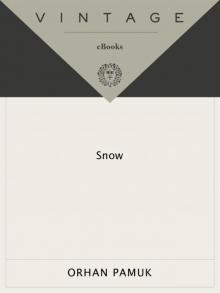 Snow
Snow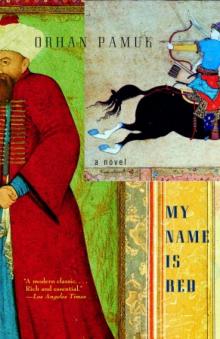 My Name is Red
My Name is Red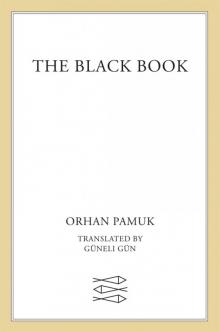 The Black Book
The Black Book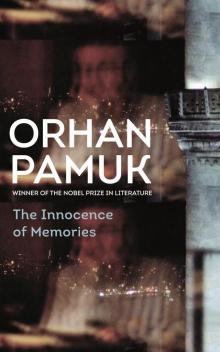 The Innocence of Memories
The Innocence of Memories The White Castle
The White Castle Other Colors
Other Colors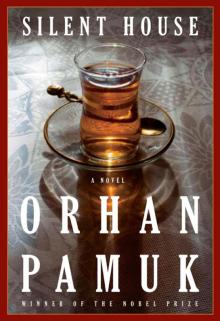 Silent House
Silent House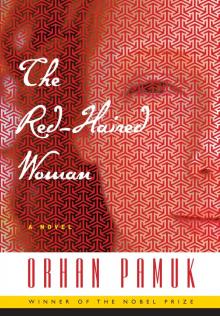 The Red-Haired Woman
The Red-Haired Woman The Museum of Innocence
The Museum of Innocence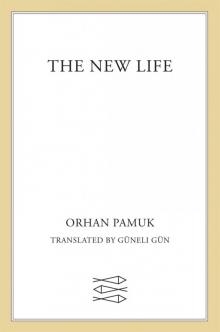 The New Life
The New Life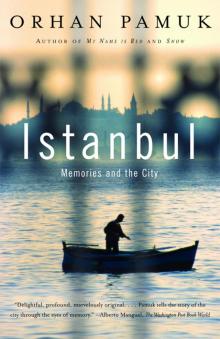 Istanbul
Istanbul